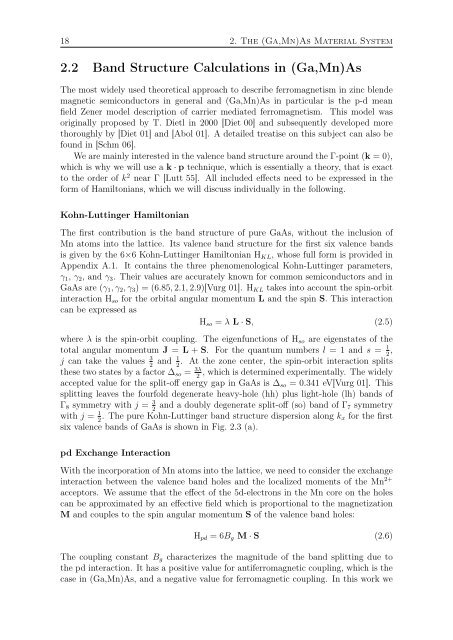Ferromagnetic (Ga,Mn)As Layers and ... - OPUS Würzburg
Ferromagnetic (Ga,Mn)As Layers and ... - OPUS Würzburg
Ferromagnetic (Ga,Mn)As Layers and ... - OPUS Würzburg
Create successful ePaper yourself
Turn your PDF publications into a flip-book with our unique Google optimized e-Paper software.
18 2. The (<strong>Ga</strong>,<strong>Mn</strong>)<strong>As</strong> Material System<br />
2.2 B<strong>and</strong> Structure Calculations in (<strong>Ga</strong>,<strong>Mn</strong>)<strong>As</strong><br />
The most widely used theoretical approach to describe ferromagnetism in zinc blende<br />
magnetic semiconductors in general <strong>and</strong> (<strong>Ga</strong>,<strong>Mn</strong>)<strong>As</strong> in particular is the p-d mean<br />
field Zener model description of carrier mediated ferromagnetism. This model was<br />
originally proposed by T. Dietl in 2000 [Diet 00] <strong>and</strong> subsequently developed more<br />
thoroughly by [Diet 01] <strong>and</strong> [Abol 01]. A detailed treatise on this subject can also be<br />
found in [Schm 06].<br />
We are mainly interested in the valence b<strong>and</strong> structure around the Γ-point (k = 0),<br />
which is why we will use a k · p technique, which is essentially a theory, that is exact<br />
to the order of k 2 near Γ [Lutt 55]. All included effects need to be expressed in the<br />
form of Hamiltonians, which we will discuss individually in the following.<br />
Kohn-Luttinger Hamiltonian<br />
The first contribution is the b<strong>and</strong> structure of pure <strong>Ga</strong><strong>As</strong>, without the inclusion of<br />
<strong>Mn</strong> atoms into the lattice. Its valence b<strong>and</strong> structure for the first six valence b<strong>and</strong>s<br />
is given by the 6×6 Kohn-Luttinger Hamiltonian H KL , whose full form is provided in<br />
Appendix A.1. It contains the three phenomenological Kohn-Luttinger parameters,<br />
γ 1 , γ 2 , <strong>and</strong> γ 3 . Their values are accurately known for common semiconductors <strong>and</strong> in<br />
<strong>Ga</strong><strong>As</strong> are (γ 1 , γ 2 , γ 3 ) = (6.85, 2.1, 2.9)[Vurg 01]. H KL takes into account the spin-orbit<br />
interaction H so for the orbital angular momentum L <strong>and</strong> the spin S. This interaction<br />
can be expressed as<br />
H so = λ L · S, (2.5)<br />
where λ is the spin-orbit coupling. The eigenfunctions of H so are eigenstates of the<br />
total angular momentum J = L + S. For the quantum numbers l = 1 <strong>and</strong> s = 1,<br />
2<br />
j can take the values 3 <strong>and</strong> 1 . At the zone center, the spin-orbit interaction splits<br />
2 2<br />
these two states by a factor ∆ so = 3λ , which is determined experimentally. The widely<br />
2<br />
accepted value for the split-off energy gap in <strong>Ga</strong><strong>As</strong> is ∆ so = 0.341 eV[Vurg 01]. This<br />
splitting leaves the fourfold degenerate heavy-hole (hh) plus light-hole (lh) b<strong>and</strong>s of<br />
Γ 8 symmetry with j = 3 <strong>and</strong> a doubly degenerate split-off (so) b<strong>and</strong> of Γ 2 7 symmetry<br />
with j = 1. The pure Kohn-Luttinger b<strong>and</strong> structure dispersion along k 2 x for the first<br />
six valence b<strong>and</strong>s of <strong>Ga</strong><strong>As</strong> is shown in Fig. 2.3 (a).<br />
pd Exchange Interaction<br />
With the incorporation of <strong>Mn</strong> atoms into the lattice, we need to consider the exchange<br />
interaction between the valence b<strong>and</strong> holes <strong>and</strong> the localized moments of the <strong>Mn</strong> 2+<br />
acceptors. We assume that the effect of the 5d-electrons in the <strong>Mn</strong> core on the holes<br />
can be approximated by an effective field which is proportional to the magnetization<br />
M <strong>and</strong> couples to the spin angular momentum S of the valence b<strong>and</strong> holes:<br />
H pd = 6B g M · S (2.6)<br />
The coupling constant B g characterizes the magnitude of the b<strong>and</strong> splitting due to<br />
the pd interaction. It has a positive value for antiferromagnetic coupling, which is the<br />
case in (<strong>Ga</strong>,<strong>Mn</strong>)<strong>As</strong>, <strong>and</strong> a negative value for ferromagnetic coupling. In this work we
















